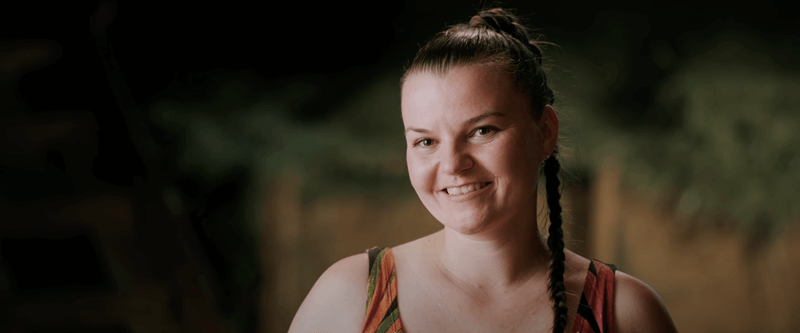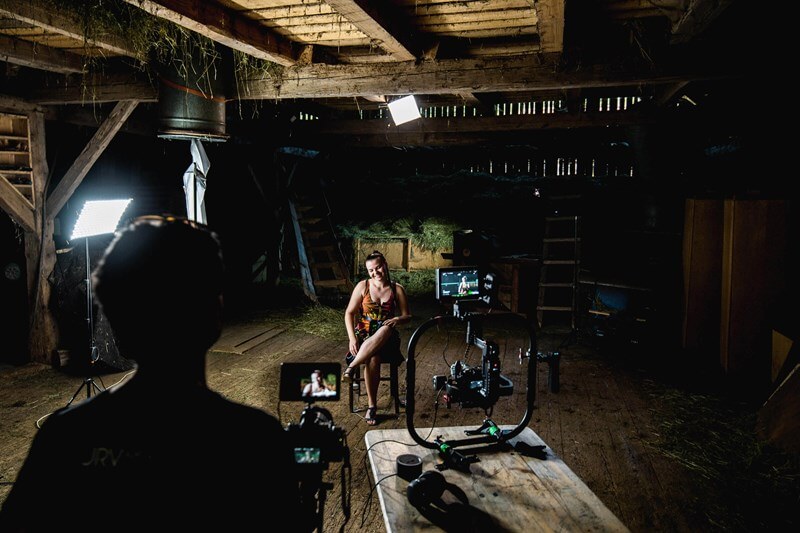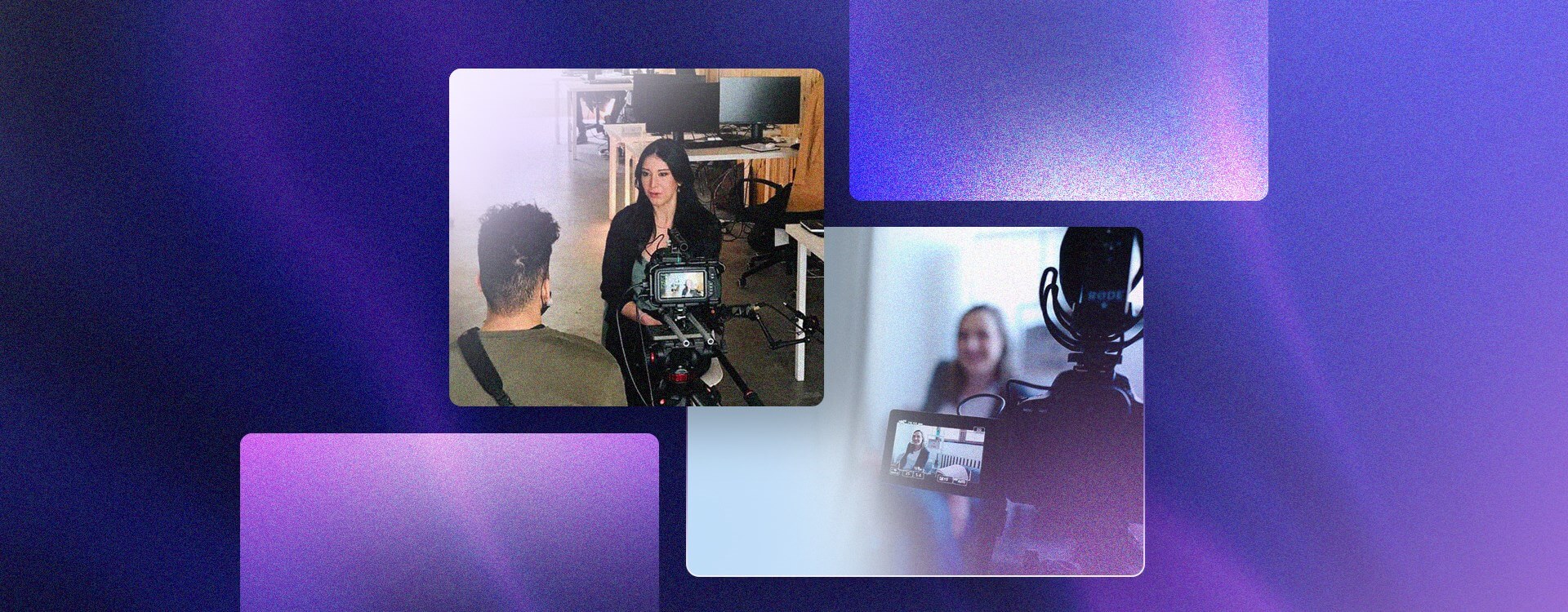Highlights
Table of Contents
Explore article topics
Interviews are standard in documentaries, branded content videos, commercials or video portraits, so better to be ready.
Interview videos look more simple than they are. In the end, it’s a person talking, telling a story or answering questions. Easy, right? Well, different factors will make your interview shoot look professional or not.
Because they happen in relatively controlled scenarios, interview videos are an excellent way to improve as a filmmaker. If you know how to film an interview, you will have control of many aspects of filmmaking in general.
Research before the interview
It’s nice to know about lighting or framing, but first things first: an interview is all about its content. No matter how good your interview looks and sounds, nobody will watch if the content is dull or flat. Therefore, before talking about technical aspects, you should prepare your interview to make the most out of it.
The first step is to research your subject. Go online, find articles, study the subject’s backstory, take notes, be a detective. When you finally meet the interviewee, this research will show how much you care about the interview. This step is mandatory if you are filming a video for a client, but it is equally crucial to film a personal project, especially about a sensitive topic.
First meeting
The first time you meet your talent, you will get the first clues for your video interview. It is your chance to break the ice positively. Use your sixth sense and your empathy. Be polite, be on time, do your homework and show interest. Here, first impressions count.
If the subject trusts you, your interview will feel more like a natural conversation than a cold set of questions. The more respect you show by being interested in the story, the more honest and powerful answers will be.
Look and listen. Listen to the words, the voice tone, the nuances. Look at the subject’s face, body language, etc. Is the person nervous, calling for handheld and casual camera work? Is he calm, suggesting a more classic and static approach? Start gathering information in your mind in this first contact, narratively and aesthetically.
Sometimes your first meeting will be on the same day as the shooting. The same concepts apply. Just be faster.
Studio vs. location interview
Your interview will take place in a studio or on location. Shooting on location has its pros and cons. They look authentic and you will be able to film in an area that relates to your character (like a library for a writer). However, you will have to deal with background noises or changes in lighting, to mention some problems.
If you shoot in a studio, you will have control over these aspects, but at the same time, you could find that it lacks personality. Maybe you are looking for a neutral background to emphasize the subject’s objectivity (interviewing a scientist, for example). There’s no right or wrong choice here. Make your decision taking into account what your interview video needs.
Framing your interview
An excellent way to start filming interviews is to follow the classic approach: medium shots or close-ups. Medium shots work for introductions or general topics, whereas close-ups work better for significant moments of the interview. If you are filming with one camera, frame for a medium shot in a high resolution and crop later in post to get a close-up.

medium shot vs. close-up shot
What angle should I film my interview?
A safe bet is to film at eye level unless you look for a specific effect (e.g. shooting from above to express anxiety). This approach is common in corporate interview videos or educational content. Experiment, but don’t get crazy unless you want to communicate something particular.
Where should the interviewee look?
An interviewee looking into the camera will feel more connected to the audience, but it can feel a bit intimidating. On the other hand, a person looking far from the camera could feel disconnected and out of place. Try to look for balance here, with the interviewer sitting next to the camera. This is a natural way to make the interviewee look genuine and engaging.

Also, if the subject is looking in one direction, try to leave more space in that direction when framing your shot.
How to light an interview
Interview lighting can be as simple or complicated as you like. However, you won’t have much time to light your interviews on many occasions. In those cases, the simpler, the better. Lighting with a key light from one side will give you a pleasant and tridimensional image out of the box, and it’s a fast way to light an interview.

If you’re shooting in natural light, try to find a window where the sun is not hitting and make it your key light. If the day is overcast, this will work too. If the light is constantly changing, block it and use your gear, or there will be lighting inconsistencies.
If you use your gear, try to motivate your lighting by placing your key light on the same side of a window. The key light is the first stroke of your canvas, and it works well for interview lighting. Optionally, you can diffuse it and add a subtle touch of fill light or negative fill if needed. Finally, some backlight will help separate your subject from the background.
As we said, you have infinite options. From a casual to a highly stylized interview, depending on your story. Is it a dark character? An optimistic one? Do you want soft light or hard light to make it either pleasant or dramatic? Feel free to experiment.
Get unlimited royalty-free 4K footage
How to do the interview’s audio setup
If you want to know how to film an interview like a pro, you need to master audio. When shooting on location, getting clean audio can be a nightmare. If you shoot in a noisy area, try to minimize the issue. Put on your headphones and listen carefully. Noises usually come from AC and heating systems, open windows, people talking in the next room, fluorescent lights, refrigerators, etc.
Empty walls make the sound bounce and create unwanted reverb. You can address this by hanging sheets around your talent. It is a cheap alternative to proper sound isolation.
Don’t forget to record a room tone track of 15-20 seconds with everybody on set quiet. It will be helpful to hide dialogue cuts and as a reference for your noise reduction software.
Make sure to mic your interviewees appropriately. With lapel mics, avoid clothing rustle or any movement from necklaces, etc. Aim the mic to the interviewee’s mouth and leave space for the voice to ‘breathe’ (around the chest is ok). If you use a shotgun mic, place it as close as you can before entering the frame. The closer you set it up, the better sound you will get.
Check the sound with your headphones to avoid surprises such as clothes rustling, audio not recording, etc.
Directing the interview
If how to film an interview is an art, directing is the primary discipline. As a director, you should not consider the interview a routine job where you only ask questions. Your work is to control the interview. Directing means making things go in a direction. You know more than anyone else about your interview video. You know the topics you want to highlight and the ones you don’t need.
Warm-up. Don’t ask critical questions until you feel the interviewee is comfortable. Remember: you are dealing with human beings. If you show interest and listen genuinely, they will look more relaxed and less artificial on camera. Interact, smile, turn the interview into a conversation without being pushy. Don’t hide behind the camera expecting the talent to relax because you said ‘Just be natural’.
Keep the conversation alive with tags like ‘really?’ Or ‘Wow, and how did that happen?’ ‘That sounds interesting. Could you expand a bit more?’ Let them talk without interruption; you will get some golden nuggets for your edit. Remember, the most beautiful shot can’t compete with an honest and touching answer from your interviewee.
A final tip: Some of the best answers happen when people think the interview is over. Just pretend you stopped recording and keep rolling.
Jose Prada is a filmmaker, musician and writer based in the UK and Spain. He has won several awards with short films and commercials and has published filmmaking courses on different platforms. jrvisuals.co.uk, the production company he founded together with Rene Strgar contributes high-end stock footage to Artgrid.
Share this article
Did you find this article useful?
Related Posts
- By Robert Hardy
- 2 MIN READ
- By Artlist
- 5 MIN READ
Latest Posts
- 17 Apr
- By Daniela Bowker
- 7 MIN READ
- 15 Apr
- By Rebecca Helfenbaum
- 4 MIN READ
